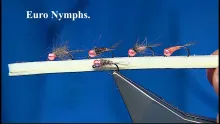First things first - I really enjoyed this book.
Updated or edited 9 months ago
First things first - I really enjoyed this book. So much so, that I've been scouring my mail order catalogs searching for the materials he uses, because I want to add some of his patterns to my fly boxes.
As the title suggests, Shane's book is devoted to mayfly imitations of each major stage - nymph, emerger, adult, and spinner - top to bottom as he says. For each section, he offers up several patterns, each with a introductory essay, step-by-step tying instructions, and a list of variations.
What I found fascinating about his flies is that he managed to achieve realism with minimal materials and tying steps. These are not "eyeballs and elbows" flies, yet they are imitative in style. With a modest selection of materials, he has given readers a huge variety of patterns that can be adapted to the mayflies found in the their
own streams.
While the bulk of the book is devoted to his flies and tying instructions, the opening chapters deal with materials and tools. Fortunately for us, Shane does not go off onto a Fly Tying Materials 101 course. With a keen sense of the reader, he keeps the subjects tuned to the flies presented in the book, keeping his comments brief and relative to his needs and in support of subsequent sections. While most of us have our own favorite tools, I don't mind his offering an opinion on his favorites. Whenever someone of Shane's skill cares to share an opinion or two, it would be in our best interest to pay attention.
In addition to the discussion of tools and materials, he has a short chapter that is devoted to techniques used throughout the book. Whether a treatise on trailing shucks, a step-by-step tutorial on extended bodies, or the various styles of biot bodies, each topic is presented in details and supported with crisp, clear color photographs. I found the balance between photos and text in the book to be right on - enough photos to illustrate each point, with supporting text to carry us from step to step. The pace of information flow is brisk, but nothing has been omitted in the name of space savings.
The meat of the book is the chapters devoted to mayfly nymphs, emergers, adults, and spinners. Each chapter contains many individual sections devoted to a specific fly pattern. These sections open with a brief essay about the fly and the insect or stage they are intended to imitate, including photos of both the real insect and the finished fly. This is followed by step-by-step tying tutorials, ending with pattern recipes for variations on the presented pattern.
As mentioned before, the photos are outstanding and the text is clear and easily followed. The flies are not complex to tie - most having just a few materials and using basic tying techniques, yet the finished results are quite clever- the hallmark of someone who has made a living tying flies to be fished.
It is obvious to me that many of his adult imitations are designed to be fished on the placid waters of spring creeks or big tailwaters. Most of them are designed to ride low in the surface and are made of materials that are relatively soft and sparse. While this provides realism in both look and feel, it could lead to frustration for those anglers who try to use these on a bouncy freestone stream. Then again, most hatch matching situations are found in smoother waters, so we can't fault Mr. Stalcup for recognizing this fact and incorporating it into his designs. High floating attractor dry flies would be out of place here.
If you have a favorite hatch you like to match, pick this book up and give a few of these flies a try. You won't break the bank, but you might net a few more trout.
- Log in to post comments








I just looove this o
I just looove this one!
Tom